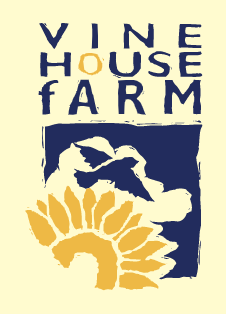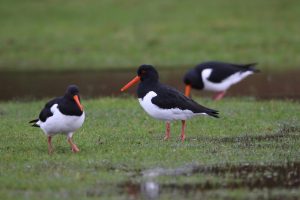
Although the Met Office might say it is the warmest February since records began, here at Deeping St Nicholas it was quite a bit warmer in February 1990. That year, there was only one frost in February, this year we have had frosts on eight mornings. Average temperature this year is 6.7°C, in 1990 it was 7.15°C. Rainfall has been below average with just 1 inch or 25mm, but in the last 48 years we have had 18 drier Februarys – it appears that February is quite often a dry month.

Whilst it is nice to have the lovely spring weather, it will not do farmers any good at all, as it is unseasonal. The only farmers I know who will be glad of it are those who are lambing. We need seasonal weather for farming.
The sprayer has been on the fields to kill off the oil radish, which was direct drilled the day after the wheat was harvested. We don’t harvest the oil radish, it’s a catch crop that conditions the soil. The oil radish has a good tap root which helps drainage, it covers the ground which stops the soil blowing if it is a light soil, it captures the nitrogen in the soil while it is growing and it stops the soil from running off the field when there is heavy rain.
Continual cultivation of our soils degrade them, as we are gradually killing off all the invertebrates. Direct drilling, that is drilling without cultivation, is good for the soil, and invertebrates like it. We don’t turn their homes upside down and they can continue to make more drainage channels in the soil. Most like decaying vegetable matter so they come above ground to feed and then the birds feed on them.
Direct drilling depends on Roundup or Glyphosate to kill the weeds before we sow the next crop, if Roundup was ever banned we would have to cultivate our soils more which is bad for our soils. Glyphosate, and its many uses in the agricultural and leisure industries, is coming under increasing pressure for its use to be restricted, due to health and environmental concerns. All agro chemicals are reviewed and given licenses for their use by the EU. It is fair to say that licenses are becoming increasingly difficult to obtain.
Farmers and scientists continue to talk about how good direct drilling is for the soil health, but I rarely hear anyone else say that it increases bird life. Do others not notice how good it is for birds; does the bird life not increase much on other people’s farms or is the increase such a trivial matter that it isn’t worth mentioning or they just don’t notice?
Some of the potatoes that we grow for MacDonald’s have not been keeping very well, a few have been going rotten so we are having to send them away early, which means a reduction in price. McCain’s, the chip manufacturers, need the potatoes so they will take them all, our potato grader is a high capacity machine and we can load 200 tons in a day, seven lorry loads, without too much trouble.
We have been busy in the workshop with repairs and modifying the trailers and attachments that the JCB telescopic handler uses. Within a couple of minutes, the tines on the front can be changed over to a grain bucket or a bale spike. This extremely useful machine is capable of assisting with a large number of duties.


In the morning half-light the yard is full of bird song: Robins, a Song Thrush and a Wren are all claiming their territory. The centre of all this is the farm shop as this is where we have been feeding mealworms for several years. The most important time of year for birds is the breeding season and if there is a ready supply of large insects available, it is worth fighting for. There is other food around the yard, in the form of seed as we are always moving our home grown seed around and bits get dropped here and there.
We’ve had some sheep on our wet grass land at Baston Fen, so all the grass was eaten to make a very short sward. Now it is just starting to look green again, and the Wigeon have now moved in, numbers have built up and on February 24th there were around 800 feeding away. There were also six Shoveler, 25 Teal, 75 Lapwings, 10 Mallard and four Oystercatchers with them; the Shoveler, Mallard and Oystercatchers have come back to breed. The Oystercatchers and Lapwing need a short sward to nest on as they want to be able to see danger approaching. The ducks need longer vegetation to hide themselves, which is why the ducks are brown in colour. There are three islands on the grassland which the sheep did not get to and that is where they will nest.
The Wigeon are here just for the winter and will return north and east to breed; some could even go as far as Siberia. It is a long way but the food is plentiful there. There is an annual harvest everywhere, but in Siberia before the wildlife finish it, the harvest is put in the ‘deep freeze’ and the birds are forced to move south and west. They keep moving in front of the snow and ice, until they arrive in places that don’t freeze up and that is where they spend the winter. They will return north and east and feed as they go.
When they arrive in Siberia, the harvest is just defrosting; some on plants, some under water which the diving ducks can get and other seeds and plants are floating on the surface, which other species will find. Before last summer’s harvest has been finished, the insects have come out and there is plenty of food for everyone. That is why it is worth going all that way to breed.
The birds that are not quite so lucky are those that migrate to Iceland and Greenland as they cannot feed as they go north. They have to put on weight for the journey across the ocean and in case their landing area is still frozen up! Last summer the Knot took off from northern Norway at the end of May to go to northern Greenland, only to find that northern Greenland was still frozen. They hung around for a few days, the snow did not melt, so they flew back to Norway and did not breed last year.
All this month I have been undertaking bird surveys for the BTO, and as early as 6th Feb some birds – Dunnocks and Yellowhammers – were on territory. Most of them were not singing, but they were just calling – as if to say ‘I am here, this is my patch’. The reason I presumed they were on territory is because that is where birds were singing last year in April and May. I have surveyed that area during the summer, for the last 25 years.
TALKS & EVENTS
Nicholas is giving talks on Farming and Wildlife at:
19th March: Market Bosworth Natural History Society
28th March: Riseholme University breakfast meeting
12th April: Southport RSPB in Lancashire
Please contact nicholas@vinehousefarm.co.uk for details



